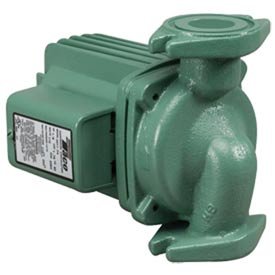In this presentation, Gary Klein shares important information about air source heat pump water heaters (HPWH), with particular attention paid to where the warm air comes ...
Adjusting the Flow Rate for an Old Gravity-Hot-Water System

About eight blocks from my house in Baltimore, there is a large two-family house with an equally large hot-water heating system that originally circulated by gravity. The original boiler, a Spencer #2-5 magazine-feed coal boiler installed in 1925, is still in service. It is rated 1600 square feet EDR.
This boiler is of the "split section" type, that is, each section is split into two pieces which are bolted together. The result is essentially two boilers in one. The two sides of the boiler are connected by two headers- one at the bottom rear, the other at the top. The top header feeds into the supply lines to the radiators. The old gravity returns were connected to 4-inch tappings in each side of the boiler. There's also an exhaust header leading to the smoke pipe.
The system had been"modernized" sometime in the 1940's. An Esso oil burner, firing 3.5 GPH, replaced the coal grates, the open expansion tank in the attic was replaced with a basement compression tank, and a circulator was mounted on the return line. At some point a Paracoil "side-arm" tankless heater was added also.
The problems started when the Esso burner was replaced with a Beckett SF. The oil company did not reduce the firing rate to compensate for the hotter flame the Beckett produces. The boiler began behaving very strangely. When it ran for a while, the pressure would suddenly begin rising very quickly. When it got to 30 pounds, the safety valve would blow and blow. And if the process went on for a while, the boiler would leak at the rear. The lady almost choked when I told her what a new boiler would cost, so I added some sealer which stopped the leaking.
I had the lady tell the oil company to reduce the nozzle size to 3 GPH and re-tune the burner to match the new nozzle. That helped, but did not solve the problem. Adding compression tank capacity got things under control, but it still didn't feel right. Massive waves of intense heat rolled off that boiler when it was running. The Beckett roared and the circulator hummed away, but the house took forever to get warm. She wasn't getting her money's worth from that 3 GPH.
Then it came time to replace the old mercury thermometer on the boiler- it originally had a separate thermometer and pressure gauge. I got as big a tridicator as I could find so she could read it easily, mounted it in the left side of the boiler, and at the same time replaced the strap-on aquastat with an immersion type in the right side. Surprise - the water temperature in the right side of the boiler was 20 degrees lower than the left side!
So I went back to the beginning.
This system originally had 1450 square feet of radiation. The sun porch radiators had frozen and burst years ago so we were down to 1300 square feet. When the circulator was put in, they used a 3-inch Thrush. The original 3-inch Thrush would pump 70 GPM at the very low head pressure in an old gravity system. At some point the Thrush wore out and was replaced with a 3-inch B&G. Here was part of the problem - the B&G 3-inch circ would pump 115 GPM! The water was moving through that system so fast it couldn't pick up enough heat from the boiler, or shed it in the radiators. No wonder the boiler metal overheated and leaked at the section joints. And I'll bet the sudden pressure increase was caused by bubbles of steam forming in there, because the metal was so hot.
Compounding the problem was the way the circulator return entered the boiler.
Remember, this is a split-section design. The return entered the right side of the boiler but there was no direct connection to the left side. Whatever water reached the left side had to flow through the bottom header. Also, the feed for the side-arm heater was taken from the right side. No wonder the boiler leaked right near the return connection - that's where the maximum flow was!
Doing the calculations in the B&G handbook from 1940, I determined this system needed aflow of 40 GPM. So I took off the side-arm heater and the 3-inch circ, installed a Taco #111 circ which will pump about 45 GPM on this installation, and ran the 1-1/2" line from the Taco into a 1-1/2"tapping in the bottom header that had been plugged (couldn't Pump Away on this one because of the way the supply header is piped). Now the water flows evenly from the bottom to the top of both sides of the boiler.
When I started it up, both sides heated evenly and the pressure stayed within normal range. And the radiators got hot in about half the time. I still say the boiler should be replaced with a modern, high-efficiency unit- but now the lady can save up for it.
("Steamhead" is Frank Wilsey. To learn more about him and his work, click here.)
Leave a comment
Related Posts

In this all-technical three-hour seminar, Dan Holohan will give you a Liberal Arts education in those Classic Hydronics systems. He’ll have you seeing inside the pipes as...
We always have turkey for Thanksgiving. I mean who doesn’t? My job wasn’t to cook it, though; it was to eat it.